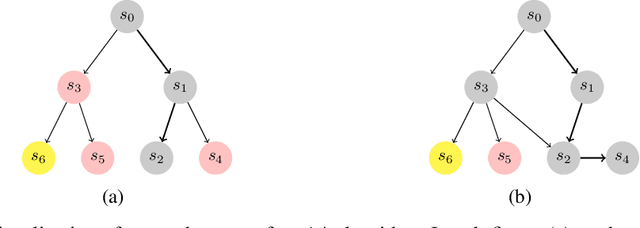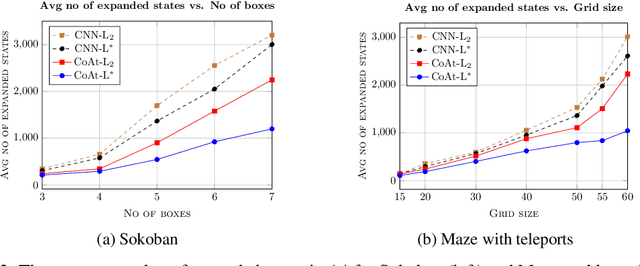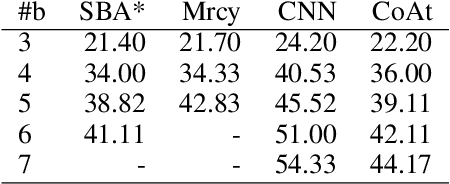Stefan Edelkamp
Planning with Vision-Language Models and a Use Case in Robot-Assisted Teaching
Jan 29, 2025



Abstract:Automating the generation of Planning Domain Definition Language (PDDL) with Large Language Model (LLM) opens new research topic in AI planning, particularly for complex real-world tasks. This paper introduces Image2PDDL, a novel framework that leverages Vision-Language Models (VLMs) to automatically convert images of initial states and descriptions of goal states into PDDL problems. By providing a PDDL domain alongside visual inputs, Imasge2PDDL addresses key challenges in bridging perceptual understanding with symbolic planning, reducing the expertise required to create structured problem instances, and improving scalability across tasks of varying complexity. We evaluate the framework on various domains, including standard planning domains like blocksworld and sliding tile puzzles, using datasets with multiple difficulty levels. Performance is assessed on syntax correctness, ensuring grammar and executability, and content correctness, verifying accurate state representation in generated PDDL problems. The proposed approach demonstrates promising results across diverse task complexities, suggesting its potential for broader applications in AI planning. We will discuss a potential use case in robot-assisted teaching of students with Autism Spectrum Disorder.
Heuristic Planner for Communication-Constrained Multi-Agent Multi-Goal Path Planning
Dec 18, 2024Abstract:In robotics, coordinating a group of robots is an essential task. This work presents the communication-constrained multi-agent multi-goal path planning problem and proposes a graph-search based algorithm to address this task. Given a fleet of robots, an environment represented by a weighted graph, and a sequence of goals, the aim is to visit all the goals without breaking the communication constraints between the agents, minimizing the completion time. The resulting paths produced by our approach show how the agents can coordinate their individual paths, not only with respect to the next goal but also with respect to all future goals, all the time keeping the communication within the fleet intact.
SIL-RRT*: Learning Sampling Distribution through Self Imitation Learning
Nov 26, 2024Abstract:Efficiently finding safe and feasible trajectories for mobile objects is a critical field in robotics and computer science. In this paper, we propose SIL-RRT*, a novel learning-based motion planning algorithm that extends the RRT* algorithm by using a deep neural network to predict a distribution for sampling at each iteration. We evaluate SIL-RRT* on various 2D and 3D environments and establish that it can efficiently solve high-dimensional motion planning problems with fewer samples than traditional sampling-based algorithms. Moreover, SIL-RRT* is able to scale to more complex environments, making it a promising approach for solving challenging robotic motion planning problems.
CLIP-Motion: Learning Reward Functions for Robotic Actions Using Consecutive Observations
Nov 06, 2023Abstract:This paper presents a novel method for learning reward functions for robotic motions by harnessing the power of a CLIP-based model. Traditional reward function design often hinges on manual feature engineering, which can struggle to generalize across an array of tasks. Our approach circumvents this challenge by capitalizing on CLIP's capability to process both state features and image inputs effectively. Given a pair of consecutive observations, our model excels in identifying the motion executed between them. We showcase results spanning various robotic activities, such as directing a gripper to a designated target and adjusting the position of a cube. Through experimental evaluations, we underline the proficiency of our method in precisely deducing motion and its promise to enhance reinforcement learning training in the realm of robotics.
Optimize Planning Heuristics to Rank, not to Estimate Cost-to-Goal
Oct 30, 2023Abstract:In imitation learning for planning, parameters of heuristic functions are optimized against a set of solved problem instances. This work revisits the necessary and sufficient conditions of strictly optimally efficient heuristics for forward search algorithms, mainly A* and greedy best-first search, which expand only states on the returned optimal path. It then proposes a family of loss functions based on ranking tailored for a given variant of the forward search algorithm. Furthermore, from a learning theory point of view, it discusses why optimizing cost-to-goal \hstar\ is unnecessarily difficult. The experimental comparison on a diverse set of problems unequivocally supports the derived theory.
A Differentiable Loss Function for Learning Heuristics in A*
Sep 12, 2022



Abstract:Optimization of heuristic functions for the A* algorithm, realized by deep neural networks, is usually done by minimizing square root loss of estimate of the cost to goal values. This paper argues that this does not necessarily lead to a faster search of A* algorithm since its execution relies on relative values instead of absolute ones. As a mitigation, we propose a L* loss, which upper-bounds the number of excessively expanded states inside the A* search. The L* loss, when used in the optimization of state-of-the-art deep neural networks for automated planning in maze domains like Sokoban and maze with teleports, significantly improves the fraction of solved problems, the quality of founded plans, and reduces the number of expanded states to approximately 50%
Heuristic Search Planning with Deep Neural Networks using Imitation, Attention and Curriculum Learning
Dec 03, 2021



Abstract:Learning a well-informed heuristic function for hard task planning domains is an elusive problem. Although there are known neural network architectures to represent such heuristic knowledge, it is not obvious what concrete information is learned and whether techniques aimed at understanding the structure help in improving the quality of the heuristics. This paper presents a network model to learn a heuristic capable of relating distant parts of the state space via optimal plan imitation using the attention mechanism, which drastically improves the learning of a good heuristic function. To counter the limitation of the method in the creation of problems of increasing difficulty, we demonstrate the use of curriculum learning, where newly solved problem instances are added to the training set, which, in turn, helps to solve problems of higher complexities and far exceeds the performances of all existing baselines including classical planning heuristics. We demonstrate its effectiveness for grid-type PDDL domains.
Knowledge-Based Paranoia Search in Trick-Taking
Apr 07, 2021



Abstract:This paper proposes \emph{knowledge-based paraonoia search} (KBPS) to find forced wins during trick-taking in the card game Skat; for some one of the most interesting card games for three players. It combines efficient partial information game-tree search with knowledge representation and reasoning. This worst-case analysis, initiated after a small number of tricks, leads to a prioritized choice of cards. We provide variants of KBPS for the declarer and the opponents, and an approximation to find a forced win against most worlds in the belief space. Replaying thousands of expert games, our evaluation indicates that the AIs with the new algorithms perform better than humans in their play, achieving an average score of over 1,000 points in the agreed standard for evaluating Skat tournaments, the extended Seeger system.
On the Power of Refined Skat Selection
Apr 07, 2021



Abstract:Skat is a fascinating combinatorial card game, show-casing many of the intrinsic challenges for modern AI systems such as cooperative and adversarial behaviors (among the players), randomness (in the deal), and partial knowledge (due to hidden cards). Given the larger number of tricks and higher degree of uncertainty, reinforcement learning is less effective compared to classical board games like Chess and Go. As within the game of Bridge, in Skat we have a bidding and trick-taking stage. Prior to the trick-taking and as part of the bidding process, one phase in the game is to select two skat cards, whose quality may influence subsequent playing performance drastically. This paper looks into different skat selection strategies. Besides predicting the probability of winning and other hand strength functions we propose hard expert-rules and a scoring functions based on refined skat evaluation features. Experiments emphasize the impact of the refined skat putting algorithm on the playing performance of the bots, especially for AI bidding and AI game selection.
ELO System for Skat and Other Games of Chance
Apr 07, 2021



Abstract:Assessing the skill level of players to predict the outcome and to rank the players in a longer series of games is of critical importance for tournament play. Besides weaknesses, like an observed continuous inflation, through a steadily increasing playing body, the ELO ranking system, named after its creator Arpad Elo, has proven to be a reliable method for calculating the relative skill levels of players in zero-sum games. The evaluation of player strength in trick-taking card games like Skat or Bridge, however, is not obvious. Firstly, these are incomplete information partially observable games with more than one player, where opponent strength should influence the scoring as it does in existing ELO systems. Secondly, they are game of both skill and chance, so that besides the playing strength the outcome of a game also depends on the deal. Last but not least, there are internationally established scoring systems, in which the players are used to be evaluated, and to which ELO should align. Based on a tournament scoring system, we propose a new ELO system for Skat to overcome these weaknesses.
 Add to Chrome
Add to Chrome Add to Firefox
Add to Firefox Add to Edge
Add to Edge